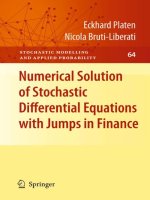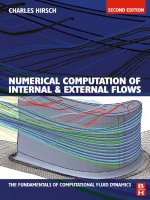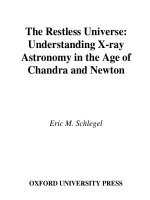Numerical solution of the age structure optimization problem for basic types of power plants
Bạn đang xem bản rút gọn của tài liệu. Xem và tải ngay bản đầy đủ của tài liệu tại đây (586.55 KB, 12 trang )
Yugoslav Journal of Operations Research
xx (2018), Number nn, zzz–zzz
DOI: />
NUMERICAL SOLUTION OF THE AGE
STRUCTURE OPTIMIZATION PROBLEM
FOR BASIC TYPES OF POWER PLANTS
Evgeniia V. MARKOVA
Melentiev Energy Systems Institute SB RAS, Lermontov 130, 664033 Irkutsk,
Russia
Inna V. SIDLER
Melentiev Energy Systems Institute SB RAS, Lermontov 130, 664033 Irkutsk,
Russia
Received: October 2017 / Accepted: February 2018
Abstract: Our paper addresses an integral model of the large electric power system
optimal development. The model takes into account the age structure of the main equipment, which is divided into several types regarding its technical characteristics. This
mathematical model is a system of Volterra type integral equations with variable integration limits. The system describes the balance between the given demand for electricity,
the commissioning of new equipment and the dismantling of obsolete equipment, as well
as the shares of different types of power plants in the total composition of the electric
power system equipment. Based on the developed model, we got numerical solution to
the problem of finding the optimal strategy for replacing equipment with a minimum
of the cost functional. The case study is the Unified Electric Power System of Russia.
Calculations of the forecast for development of the electric power system of Russia until
2050 were made using real-life data.
Keywords: Integral Models of Developing Electric Power Systems, Lifetime, Optimization Problem, Numerical Solution.
MSC: 90C90, 65D30, 45D05.
2
E.V. Markova, I.V. Sidler / Age Structure Optimization Problem
1. INTRODUCTION
Important tasks of modern electric power industry are associated with high
wear and tear of fixed production assets at low rates of upgrading it. At present,
a significant part of the main equipment at power facilities is operated beyond
the normative lifetime. This can lead to an increase in the costs of maintaining the main equipment in proper technical condition, a growth of technological
limitations, that, in turn, will affect the reliability of power supply. In this connection, analysis of the age structure of generating equipment is important for future
strategies of its upgrading.
A useful simulation tool for management of obsolete equipment is vintage capital models [6, 7, 9, 11, 18, 19, 24]. They take into account the embodied technological changes and are described by nonlinear Volterra integral equations with
variable upper and lower integration limits [8, 9, 10]. Such models are used for
qualitative investigation of the aging equipment replacement [12, 13, 14, 15, 25].
Mathematical models of generating capacities development of electric power
system are considered in the works [3, 16, 17, 21, 22]: models with different degrees of aggregation by types of power plants, estimation models (analysis of the
consequences of the specified capacity upgrading strategy) and optimization ones
(optimization of the capacities lifetime), models with describing the processes of
prolonging the lifetime of the generating equipment (modernization) or without
it.
A new integral model of the developing system was proposed in [2, 5]. It allows
us to provide a detailed description of the technical and economic parameters of
the generating power plants equipment, taking into account its age structure.
The equipment is divided into several age groups with different indicators of the
effectiveness of their functioning. The fundamentals of the theory of corresponding
Volterra equations of the first kind are presented in [2, 4].
2. INTEGRAL MODEL OF THE EPS DEVELOPMENT
To model an electric power system (EPS), we use the integral model described
in [5]. It is assumed that all equipment of the system has the same technical
characteristics. In this article, we consider a vector model of Russia’s EPS, in
which the generating equipment is divided into three groups by the types of energy
resources that they use: stations operating on fossil fuel (TPP), stations operating
on nuclear fuel (NPP), and hydro power plants (HPP). Stations of the same type
are divided into three age groups.
Introduce the following denotations for the mathematical description of the
model:
x(t) ≡ (x1 (t), x2 (t), x3 (t)) is the commissioning of electric capacities (by types
of power plants): x1 (t) corresponds to TPPs, x2 (t) corresponds to NPPs, x3 (t)
corresponds to HPPs; variable t is located in the forecast period [t0 , T ];
3
E.V. Markova, I.V. Sidler / Age Structure Optimization Problem
βij is the efficiency coefficient of the age group j or a power plant of type
i, in addition within the same age group the efficiency coefficient βij = const,
1 βi1 βi2 βi3 0, i, j = 1, 3;
y (t) is the total available capacity of the electric power system specified by the
experts for the future;
Tij (t) is the upper age limit of group j for a power plant of type i, i, j = 1, 3,
in addition 0 < Ti1 (t) < Ti2 (t) < Ti3 (t), Ti3 (t) is the lifetime of the equipment of
type i (the age of the oldest equipment of type i still in use at the moment t);
x0 (t) ≡ (x01 (t), x02 (t), x03 (t)) is the known dynamics of commissioning the capacities on the prehistory [0, t0 ) (by types of power plants);
α(t) is a given change in the share of the TPP capacity in the total composition
of generating equipment;
γ(t) is a given change in the share of the HPP capacity in the total composition
of generating equipment.
The model of the EPS development has the form of the following system of
equations:
t−Ti1 (t)
t
3
βi1
i=1
xi (s)ds + βi2
t−Ti1 (t)
t−Ti2 (t)
xi (s)ds + βi3
t−Ti2 (t)
xi (s)ds = y(t),
(1)
t−Ti3 (t)
t ∈ [t0 , T ],
t
t
t
x1 (s)ds +
x1 (s)ds = α(t)
t−T13 (t)
t−T13 (t)
t
x3 (s)ds ,
x2 (s)ds +
t−T23 (t)
t−T33 (t)
(2)
t
t
x3 (s)ds = γ(t)
t−T33 (t)
t
x1 (s)ds +
t−T13 (t)
t
x2 (s)ds +
t−T23 (t)
x3 (s)ds (3)
t−T33 (t)
with the initial conditions on the prehistory
x(t) = x0 (t), t ∈ [0, t0 ),
(4)
and the restrictions on the commissioning capacities
xi (t)
0, t ∈ [t0 , T ], i = 1, 3.
(5)
Here, equation (1) indicates the balance between the number of commissioning
capacities of different types and the available power y(t), given for the future.
Equations (2), (3) specify the required ratio of different electric power types. In
addition, it is assumed that the restoration of dismantled capacities is impossible:
Ti3 (t)
1, t ∈ [t0 , T ], i = 1, 3.
(6)
4
E.V. Markova, I.V. Sidler / Age Structure Optimization Problem
In the case of one term, the problems of the existence and uniqueness of solution
to (1) in the space C[t0 ,T ] are studied in detail in [1]. In the case of several terms,
elements of the theory of corresponding Volterra equations of the first kind are
presented in [2].
Since the solution to (1)–(3) can be explicitly set down only in some special
cases, we turn to numerical solution. Note that (1)–(3) contain integrals with
variables in both upper and lower integration limits, which means that we have
to adapt the numerical procedures used to solve the classical first kind Volterra
equations. The reader is referred to [1] for the theory and numerical methods for
solving this equation. A numerical solution by the quadrature method is characterized by accumulation of the integral approximation error over the prehistory,
which reduces its order of convergence by one. There exist some procedures of
restoring the method order, some of which can be found in [1]. For example, to
keep the order of convergence of quadrature method equal to the approximation
order of the quadrature formulae, one can use a quadrature on the prehistory
whose approximation order exceeds that of the basic one by 1.
It is possible to formulate various economic problems on the basis of the above
model. For example, if the commissioning capacities x(t) are the sought-for functions, and all other functions are known, then we obtain the problem of forecasting
the EPS development.
You can set various optimization problems using the model (1)–(5).
3. OPTIMIZATION PROBLEM
As noted earlier, the growth in the part of obsolete equipment in the structure
of Russia’s power plants leads to many negative consequences. Along with the
increase in operating costs at present, this will require a very large investment in
the future for the inevitable replacement of a large number of generating capacities.
In this regard, the problem of technical reequipment and dismantling of the main
equipment of power plants is one of the most urgent tasks for the Russian electric
power industry development.
We consider a search problem for dynamics of change in the equipment lifetime (i.e. parameter T3 (t) ≡ (T13 (t), T23 (t), T33 (t))) that minimizes total costs of
putting capacities into service and operation of capacities during the time [t0 , T ]
for a given demand for electricity y(t). Here Ti3 (t) is the moment of dismantling
capacity of type i.
We take the cost functional as the objective functional:
t−Ti,j−1 (t)
T
3
3
t−t0
i
i
I x, T3 =
a
βij
u1 (t − s)u2 (s)xi (s)ds dt+
j=1
i=1 t
t−Tij (t)
0
(7)
3
T
at−t0 ki (t)xi (t)dt, Ti0 (t) = 0, i = 1, 3.
+
i=1 t
0
E.V. Markova, I.V. Sidler / Age Structure Optimization Problem
5
Here the first term corresponds to the operating costs; the second term corresponds to the costs of putting capacities into service.
The following functions are known in (7):
ui1 (t − s) are coefficients of increase in the costs of operating the capacities of
type i at time t that are commissioned at time s;
ui2 (t) are the specific annual costs of operating the capacity of type i, commissioned at time t;
ki (t) are the specific capital costs of commissioning a capacity unit of type i
at time t;
at−t0 is the costs discount coefficient, 0 < a < 1.
The control parameter T3 (t) belongs to the feasible set
U = T3 (t) : T3
T3 (t)
T3 , Ti3 (t)
1, t ∈ [t0 , T ], i = 1, 3 .
(8)
It is required to find
T3∗ (t) = arg min I x, T3
(9)
T3 (t)∈U
under the conditions (1)–(8).
The problem (1)–(9) is nonlinear, the components of the vector T3 (t) are in the
lower limits of integration in (7) and (1)–(3). In addition, there are restrictions
on the phase variable (5). All these factors make the problem quite complex and
challenging.
4. NUMERICAL SOLUTION OF OPTIMIZATION PROBLEM
To solve the optimal control problem, we use a heuristic algorithm based on the
discretization of all the elements on a grid with step h = 1 (year) and replacement
of the feasible set U by the set Uh of piecewise linear functions
mi , t ∈ (t0 , T ],
mi Ti3 (t0 ),
t − t0 + Ti3 (t0 ), t ∈ [t0 , t0 − Ti3 (t0 ) + mi ), mi > Ti3 (t0 ), (10)
Ti3 (t) =
mi , t ∈ [t0 − Ti3 (t0 ) + mi , T ],
where mi is desired integer constant lifetime, i = 1, 3. Equation (10) means that
the maximum lifetime can be decreased abruptly and increased only by a unit
per year (according to (6)) until we reach the desired level (see Figure 1). The
upper and lower limits for the lifetimes T3 and T3 were chosen basing on physical
considerations.
On this feasible set we use enumerative technique among all possible mi , i =
1, 3. We introduce the grid of nodes with step h: tj = t0 +j, j = 1, N , N h = T −t0 .
We used the right rectangle rule with step h = 1 to approximate the integrals in
(1)–(3), (7) on the forecast period. The midpoint rule is used to approximate the
integrals on the prehistory. We employ the forecast values of economic indices
provided by experts.
Let us describe the algorithm for solving the optimization problem.
6
E.V. Markova, I.V. Sidler / Age Structure Optimization Problem
80
80
70
70
60
60
50
50
40
t0
T
40
t0
T
Figure 1: Example of two variants of transition to a constant lifetime.
Step 1. Choose the lifetime Ti3 (t) = mi , i = 1, 3, from the feasible set (10).
Step 2. For the given Ti3 (t), solve numerically the system of equations (1)–(3)
with respect to xi (t) in t = t0 .
Step 3. Check the inequality (5). If it is valid, then go to Step 4. If xi (t0 ) < 0,
then set xi (t0 ) = 0 and correct α(t0 ) and γ(t0 ) from (2)–(3). We actually
get the inequality instead of the balance equation (1).
Step 4. Return to Step 2 for the next point tj , j = 1, N , until the forecast period
ends.
Step 5. Substitute the obtained numerical solution x(t), t ∈ [t0 , T ], into a discrete
analogue (8), and calculate the value of the functional I(T3 (t), x).
Looping over all possible mi from the feasible set, we find the solution to the
problem.
The above algorithm is implemented for the scalar case as a software package
in the MatLab environment [20]. The vector statement of the problem required
some software package modifications.
5. REAL-LIFE DATA CALCULATIONS
Now we consider a solution to (1)–(9) as applied to the Unified Energy System
(UES) of Russia. The year 1950 is taken as the beginning of modeling. The
forecast period is [t0 , T ] = [2016, 2050]. The upper age limits of the groups are
T11 (t) = T21 (t) = T31 (t) = 30, T12 (t) = T22 (t) = T32 (t) = 50, T13 (t) = T23 (t) = 60,
T33 (t) = 101. The efficiency coefficients are βi1 = 1, βi2 = 0.97, βi3 = 0.9, i = 1, 3.
Using the known data from the prehistory [0, t0 ) = [1950, 2016), we find the shares
of the TPP and HPP capacities and assume them to be constant throughout the
forecast period: α(t) = 0.69, γ(t) = 0.19. The following variant was defined as a
basic one: in 2015 T13 = 60, T23 = 47, T33 = 66 (according to real-life data), in
2050 T13 = T23 = 60, T33 = 101 (lifetime increases by 1 per year). The dynamics
of commissioning capacities on the prehistory correspond to the real-life data [23].
E.V. Markova, I.V. Sidler / Age Structure Optimization Problem
7
The growth dynamics of the right-hand side at [2016, 2050] provide for a low level
of consumption (0.5% per year). The dynamics of commissioning capacities of the
UES and the average age of the UES equipment for the basic variant (Steps 2–4)
are shown in Fig. 2.
Figure 2: The basic variant.
The following data was used for the optimization problem. The functions of
the specific growth of operating costs ui1 (t − s) ≡ ui1 (τ ) are given as follows:
u11 (τ ) = u31 (τ ) =
1,
1.03τ −45 ,
τ 45,
τ > 45,
u21 (τ ) =
1,
1.1τ −45 ,
τ 45,
τ > 45,
(costs of operation capacity increase exponentially at the rate of 3% per year
after 45 years of exploitation for TPPs and HPPs, and 10% per year after 45
years of exploitation for NPPs). The functions ki (t) and ui2 (t) were taken to be
constant: k1 (t) = 1300 (USD/MW), k2 (t) = 2500 (USD/MW), k3 (t) = 3000
(USD/MW), t ∈ [2016, 2050]; u12 (t) = 189 (USD/MW), u22 (t) = 170 (USD/MW),
u32 (t) = 200 (USD/MW), t ∈ [1950, 2050]. Optimization of lifetimes of the TPP
and NPP equipment was carried out, assuming that the HPP equipment is not
decommissioned for the forecast period.
8
E.V. Markova, I.V. Sidler / Age Structure Optimization Problem
The obtained optimal lifetimes, the corresponding commissioning of the UES
capacities, and the average age of the UES equipment are shown in Fig. 3. The
optimal lifetime for the equipment of TPPs is proposed to be reduced from 60
to 53 years. The optimal lifetime for the equipment of NPPs shifts from 47 to
50 years. Mass dismantling of equipment at the beginning of the forecast period
requires a sharp increase (up to 27 GW) of commissioning capacities. Thus, by
2050 the obtained strategy will have given an economic benefit 2.31% with respect
to the basic variant.
Figure 3: The dynamics of commissioning capacities, corresponding optimal lifetimes and the
average age of generating capacities.
6. CORRECTED ALGORITHM
From the economical and technical points of view, a strategy with a mass
commissioning of equipment is unacceptable since it is related to large one-time
capital costs of commissioning of new capacities and limited technical capabilities.
Therefore, it is natural to introduce additional restrictions on the phase variable
E.V. Markova, I.V. Sidler / Age Structure Optimization Problem
9
into the statement (1)–(9):
3
xi (t)
x(t), t ∈ [t0 , T ].
(11)
i=1
It is necessary to add one step to the algorithm for solving the problem.
Step 3.1. Check the inequality (11). If it is valid, then go to Step 4. Overwise,
return to Step 1 and increase the desired mi by a unit for each type of power
plant, until (11) is executed on Step 3.1. For the next moment of time,
return to the original set m.
Note that the proposed way to account for the restriction (11) is not unique.
It depends on how important it is to keep the ratio of different types of power
plants α and γ.
To illustrate solution of the problem with the restriction on power inputs, we
take as x(t) a linear function that is equal to the maximum input of powers on
the prehistory at t0 = 2016 and triples by the end of the forecast period:
3
x(2016) =
x0i (t); x(2050) = 3 · x(2016).
max
t∈[1950,2015]
i=1
Figure 4 shows the obtained optimal lifetimes, the corresponding commissioning of the UES capacities, and the average age of the UES equipment taking into
account the restrictions. The optimal lifetime for the TPP equipment implies
gradual transition from 60 to 52 years by 2020. The optimal lifetime for the NPP
equipment shifts from 47 to 50 years. The economic benefit with respect to the
basic variant will have been 2.30% by 2050.
7. CONCLUSIONS
In this paper we considered the integral model of the optimal development
of a large electric power system using the example of the Unified Electric Power
System of Russia. We proposed a numerical algorithm for finding an optimal
strategy for replacing equipment with a minimum of the cost functional. Using
real-life data, we made calculations for the case of constant costs for commissioning
new capacities and operating generating capacities.
The results of the calculations show the efficiency of the accelerated renovation of the TPP equipment with a reduction in their lifetime from the presently
accepted 60 years to 53 years for the problem without restrictions on the commissioning of new capacities, and to 52 years for the problem with restrictions. At the
same time, it is proposed to increase the lifetime of the NPP equipment from 47 to
50 years, and the resulting benefits are 2.31% of the initial value of the functional
for the problem without restrictions on commissioning capacities, and 2.30% for
the problem with restrictions.
10
E.V. Markova, I.V. Sidler / Age Structure Optimization Problem
Figure 4: The dynamics of commissioning capacities, corresponding optimal lifetimes and the
average age of generating capacities taking into account the restrictions.
E.V. Markova, I.V. Sidler / Age Structure Optimization Problem
11
The problem of searching the optimal strategy for replacing equipment taking
into account technological changes is the subject of further research.
Acknowledgement: The authors thank V.V. Trufanov for the provided data
and helpful comments. The work was carried out within the framework of the
scientific project III.17.3.2 of the program of fundamental research of the SB RAS,
reg. No. AAAA-A17-117030310446-6. Research has been supported in part by the
Russian Foundation for Basic Research under Grant 15-01-01425.
References
[1] Apartsyn, A.S., Nonclassical Linear Volterra Equations of the First Kind, Monograph,
VSP, Utrecht–Boston, 2003.
[2] Apartsyn, A.S., “On Some Classes of Linear Volterra Integral Equations”, Abstract and
Applied Analysis, 2014 (2014) Article ID 532409.
[3] Apartsin, A.S., Karaulova, I.V., Markova, E.V., and Trufanov, V.V., “Application of the
Volterra integral equations to the modeling of retooling strategies for electric power industry”, Elektrichestvo, 10 (2005) 69-75. (In Russian)
[4] Apartsin, A.S. and Sidler, I.V., “Integral models of development of electric power systems
with allowance for aging of equipments of electric power plants”, Elektronnoe modelirovanie,
4 (2014) 81–88. (In Russian)
[5] Apartsin, A.S., and Sidler, I.V., “Using the Nonclassical Volterra Equations of the First
Kind to Model the Developing”, Automation and Remote Control, 74 (6) (2013) 899–910.
[6] Benhabib, J., and Rustichini, A., “Vintage capital, investment, and growth”, Journal of
Economic Theory, 55 (1991) 323–339.
[7] Cooley, T., Greenwood, J. and Yorukoglu, M., “The replacement problem”, Journal of
Monetary Economics, 3 (1997) 457–499.
[8] Corduneanu, C., Integral Equations and Applications, Cambridge University Press, Cambridge,1991.
[9] Glushkov, V.M., “On one class of dynamic macroeconomic models”, Upravlyayushchie sistemy i mashiny, 2 (1977) 3–6. (In Russian)
[10] Glushkov, V.M., Ivanov, V.V., and Yanenko, V.M., Modeling of developing systems, Nauka,
Moscow, 1983 (In Russian).
[11] Greenwood, J., Herkowitz, Z., and Krusell, P., “Long-run implications of investment-specific
technological change”, American Economic Review, 87 (1997) 342–362.
[12] Hritonenko, N., “Optimization analysis of a nonlinear integral model with applications to
economics”, Nonlinear Studies, 11 (2004) 59–70.
[13] Hritonenko, N., and Yatsenko, Yu., “Creative destruction of computing systems: analysis
and modeling”, The Journal of Supercomputing, 38 (2) (2006) 143–154.
[14] Hritonenko, N., and Yatsenko, Yu., Modeling and Optimization of the Lifetime of Technologies, Kluwer Academic Publishers, Dordrecht, 1996.
[15] Hritonenko, N., and Yatsenko, Yu., “Structure of optimal trajectories in a nonlinear dynamic
model with endogenous delay”, Journal of Applied Mathematics, 5 (2004) 433–445.
[16] Ivanov, D.V., Karaulova, I.V., Markova, E.V., Trufanov, V.V., and Khamisov, O.V., “Control and power grid development: numerical solutions”, Automation and Remote Control,
65 (3) (2004) 472–482.
[17] Karaulova, I.V., and Markova, E.V., “Optimal control problem of development of an electric
power system”, Automation and Remote Control, 69 (4) (2008) 637–644.
[18] Love, C.E., and Guo, R., “Utilizing Weibull failure rates in repair limit analysis for equipment replacement/preventive maintenance decisions”, Journal of the Operational Research
Society, 47 (1996) 1366–1376.
[19] Malcolmson, J.M., “Replacement and the rental value of capital equipment subject to obsolescence”, Journal of Economic Theory, 10 (1975) 24–41.
12
E.V. Markova, I.V. Sidler / Age Structure Optimization Problem
[20] Markova, E.V., and Sidler, I.V., A software package for numerical solution of the optimal
control problem of the equipment lifetime in the integral model of a large electric power
system development, Certificate of authorship 2016610223, 2016.
[21] Markova, E.V., Sidler, I.V., and Trufanov, V.V., “On models of developing systems and
their applications”, Automation and Remote Control, 72 (7) (2011) 1371–1379.
[22] Markova, E.V., Sidler, I.V., and Trufanov, V.V., “Integral models of developing electric
power systems”, International Journal of Energy Optimization and Engineering, 2 (4)
(2013) 44–58.
[23] Novak, A.V., The outcome of the work of the Ministry of Energy of Russia and
the main results of the functioning of the fuel and energy complex in 2015, Presentation for the Report of Minister of Energy of the Russian Federation. Available at
(In Russian)
[24] Van Hilten, O., “The optimal lifetime of capital equipment”, Journal of Economic Theory,
55 (1991) 449–454.
[25] Yatsenko, Yu, and Hritonenko, N, “Optimization of the lifetime of capital equipment using
integral models”, Journal of Industrial and Management Optimization, 1 (2005) 415–432.









